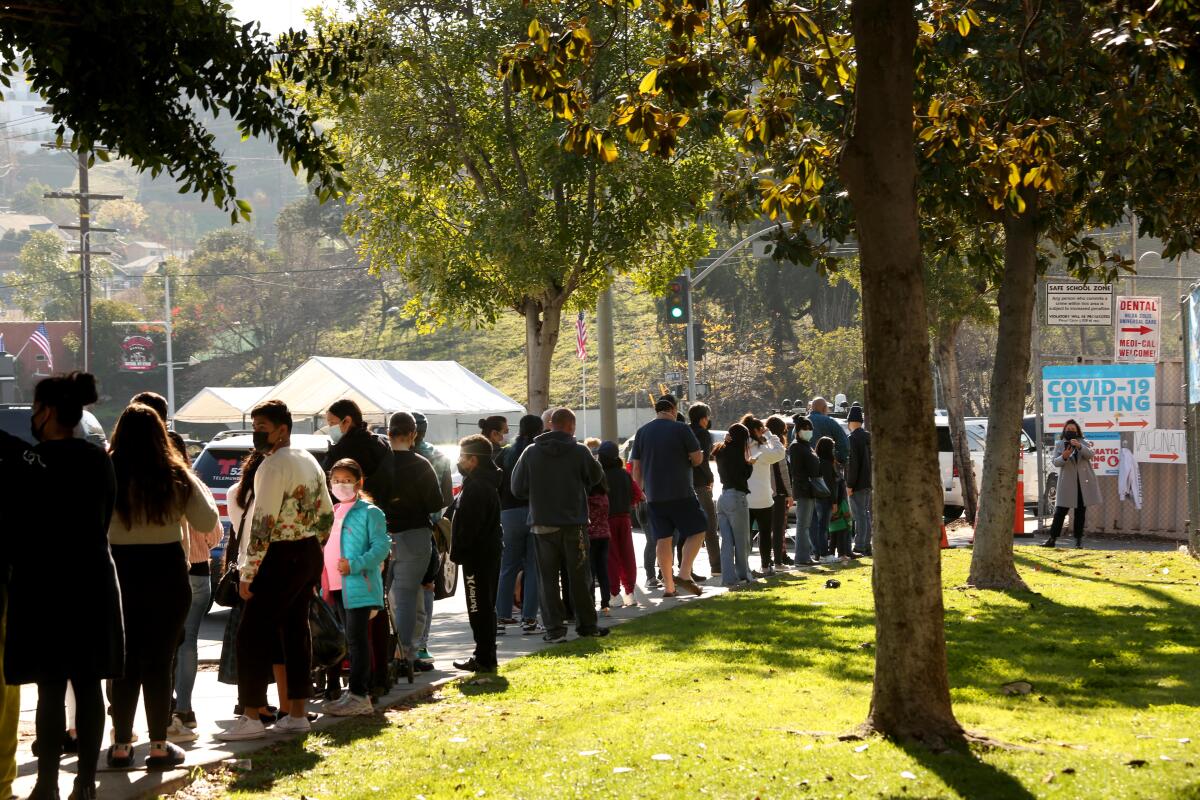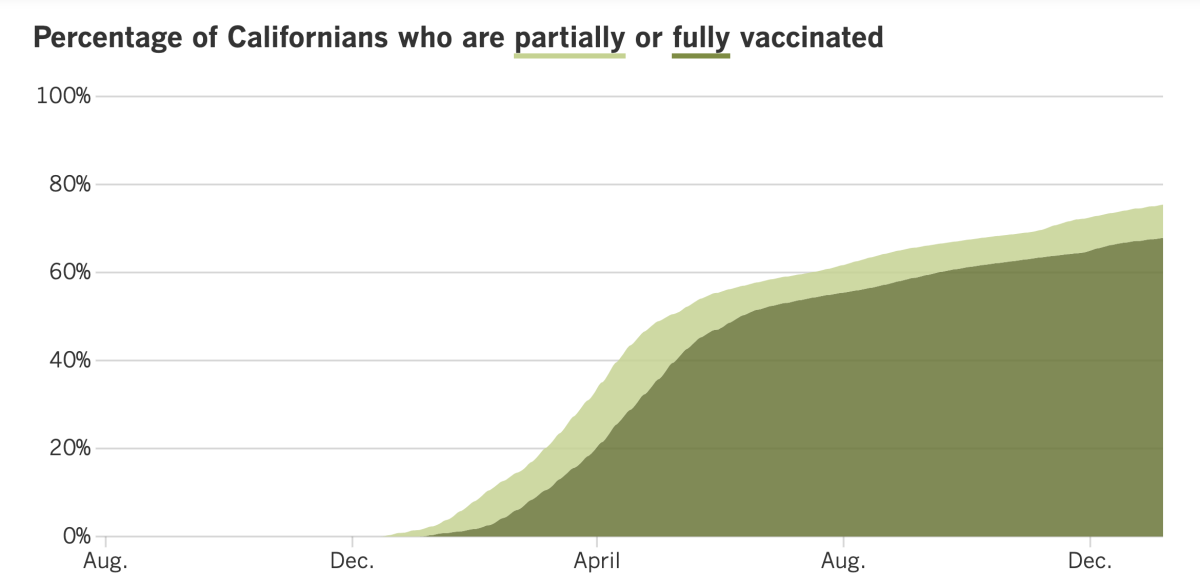Coronavirus Today: Going back to school with Omicron
- Share via
Good evening. I’m Karen Kaplan, and it’s Friday, Jan. 7. Here’s the latest on what’s happening with the coronavirus in California and beyond.
Los Angeles Unified, the nation’s second-largest school system, is supposed to welcome back more than 600,000 students next week as winter break comes to a close. What could go wrong?
Take a look at some of the districts that resumed classes this week and the answer becomes obvious: plenty.
In San Gabriel, 25 students at Gabrielino High School tested positive for coronavirus infections in the first days back. Each of those students changes classes throughout the day, so tracing each of their close contacts required a monumental effort. The school, along with nearby Jefferson Middle School, wound up closing on Thursday and Friday.
In La Cañada Flintridge, 10% of the 1,565 coronavirus tests administered Monday came back positive, prompting school officials to switch to online learning for a day and require new tests for students before allowing them back on campus.
In Santa Ana, 1 out of 10 teachers are stuck at home because they are infected or are in quarantine. Some have been able to teach remotely, with their students watching them on large screens in their classrooms.
All of this disruption comes courtesy of the Omicron variant, which is fueling record-high infection rates throughout the state and across the country.
And we thought going back to school in the fall amid the Delta surge was tricky ...
Actually, L.A. County schools fared pretty well in the first part of the school year, according to Public Health Director Barbara Ferrer. Among some 3,000 schools, there were fewer than a dozen outbreaks per week, on average.
“We did really, really well at schools in the fall,” she said. “But that will not be the case as we come back.”
Although rates of serious illnesses and deaths are nowhere near as bad as they were this time last year, the explosion of new coronavirus cases will create logistical headaches. Every confirmed infection requires at least five days of isolation, even for those with no COVID-19 symptoms. That puts a strain on school staff and disrupts learning for students.
The county implemented new rules to bolster schools’ defenses against Omicron. Among them:
- Teachers and other school employees must wear medical-grade masks, such as surgical masks, N95s or KN95s.
- Students will have to wear masks outdoors as well as indoors if they’re in crowded places, except when they’re actively eating or drinking.
- Sports teams with four or more linked cases over a two-week period must suspend group activities for at least a week and get permission from the county health department before they can resume.
L.A. Unified implemented some rules of its own, including a requirement that all students and staff take coronavirus tests — at a district site or elsewhere — before coming back to campus. Both PCR tests and at-home antigen tests are acceptable, and results must be uploaded by Sunday. The district said Friday that based on test results received so far, 13.5% of students and staff have coronavirus infections. That’s nearly 10 times higher than it was before winter break.

The goal is to make sure schools reopen safely and to provide “peace of mind,” said school board member Nick Melvoin.
Peace of mind has been in short supply for some parents whose kids are already back in classrooms.
“Please don’t take off your mask or get into a big crowd of students,” Maria Castro called out to her daughter as she headed into Long Beach Polytechnic High School on Monday. “Please, my love.”
When Castro got home, she logged onto a Zoom session her church was offering for parents. Together, they prayed for their children’s safety.
Colleges have been quicker to shift to remote learning as they start their new semesters. Eight of nine UC campuses kicked off 2022 with online classes, and four of them — in Irvine, San Diego, Santa Cruz and Davis — said they’d stay online through the end of January.
UCLA, which began its winter quarter online, currently plans to reopen classrooms on Jan. 18. UC Berkeley is the only UC campus with no current plans for remote instruction. The spring semester there starts Tuesday.
At least nine Cal State campuses — in Los Angeles, Long Beach, San Diego, San Marcos, San Francisco, the East Bay, Sacramento, Fresno and the Channel Islands — have also delayed in-person classes. More may join them. Pasadena City College and other community colleges around the state have decided to start the new semester online as well.
Cal Poly San Luis Obispo started on-campus classes this week. But so many students tested positive that, by Wednesday, it was housing infected students in hotels. By Thursday, the school had 62 isolation beds on campus and another 132 in hotels.
However the state’s K-12 students go back to school, they’ll have lots of ground to cover. Testing data released Friday show that elementary and secondary pupils had significant academic setbacks during the 2020-21 school year, most of which was conducted online.
About half of all California students fell short of state standards in English language arts, and about two-thirds missed the mark in math. The results were worse for Black, Latino and economically disadvantaged students, with more than 60% testing below standards for English and 80% doing so for math.
“The challenges that students and educators faced during the pandemic were multidimensional,” said State Superintendent of Public Instruction Tony Thurmond in a statement. “Our goal now is to move all students forward.”
By the numbers
California cases and deaths as of 5:15 p.m. Friday:

Track California’s coronavirus spread and vaccination efforts — including the latest numbers and how they break down — with our graphics.
The legacy of Kelly Ernby
A little over a month ago, Kelly Ernbry stood outside Irvine City Hall and denounced COVID-19 vaccine mandates. She told an audience that numbered in the dozens that such mandates were a sign of socialism and amounted to an unforgivable loss of personal freedom.
“There’s nothing that matters more than our freedoms right now,” Ernby said at the Dec. 4 rally, according to an account in the Daily Titan, a Cal State Fullerton student newspaper.
Her opposition to vaccine mandates predated the pandemic. In 2019, when she was running for a seat in the state Assembly, she explained her views on a then-new law that tightened immunization rules for California students.
“I don’t think that the government should be involved in mandating what vaccines people are taking,” she said during an online town hall. “I think that’s a decision between doctors and their patients. ... If the government is going to mandate vaccines, what else are they going to mandate?”
Ernby, a 46-year-old rising star in the Orange County Republican Party, wasn’t just opposed to COVID-19 vaccine mandates. Apparently, she wasn’t a fan of the shots themselves.
That stance may have cost Ernby her life. She died this week of COVID-19.
Americans in their 40s who don’t have chronic health conditions rarely develop severe cases of COVID-19 — if they are vaccinated against the disease.
“She was NOT vaccinated,” her husband, Axel Mattias Ernby, wrote on Facebook. “That’s the problem.”

Over the past several days, thousands of people have left comments on her Facebook page. Some of them offered condolences. Others shared memories of a woman who served for 10 years as an Orange County deputy district attorney, where she was a member of the office’s Environmental Protection Team.
And of course, there were plenty of variations of “I told you so.”
“I’ve got the schadenest freude right now,” one wrote.
Another commended her for “winning your very own Darwin award.”
Hundreds of similar messages also made their way to Ben Chapman, chairman of the Greater Costa Mesa Republicans and a friend of Ernby’s. He described the emails, tweets and other social media comments as “disgusting” and “bigoted.”
He also found them unpersuasive. Like Ernby, Chapman has chosen to forgo the lifesaving shots.
“I will never get vaccinated, nor will I urge my friends to get vaccinated,” Chapman wrote on Twitter.
(Let us pause for a moment to reflect on the latest statistics from the California Department of Public Health, which show that unvaccinated residents are 10.1 times more likely than their vaccinated peers to be hospitalized with COVID-19, and 16.6 times more likely to die of the disease.)
Officials from the World Health Organization all the way down to the Orange County Health Care Agency agree that getting more people vaccinated is the fastest and safest way to bring the pandemic to an end. Posting snarky comments on social media isn’t likely to move the needle.
Among the dozens of comments I read, this one is my favorite:
“I would like to thank her husband for leaving these comments open for discussion. I would also like to thank him for being honest and telling people she was not vaccinated and that was the problem. Her death will not be in vain as long as her husband keeps communicating the truth about what happened. Hopefully he contacts some of the national news outlets and shares his story in an effort to prevent future senseless tragedies like this.”
California’s vaccination progress


See the latest on California’s vaccination progress with our tracker.
Your support helps us deliver the news that matters most.
In other news ...
Thanks to Omicron, Los Angeles County keeps on breaking coronavirus records. Officials said 43,712 new cases were reported Friday — a new single-day record — bringing the total number of new cases this year to nearly 220,000.
That’s the bad news. The good news is that the number of critically ill COVID-19 patients is far lower than it was during last winter’s devastating surge.
On Thursday, there were 2,902 patients with coronavirus infections in L.A. County hospitals, including 391 in ICU beds. They accounted for about 7% of all intensive care patients; by contrast, during the Delta wave, 15% of ICU beds were taken up by COVID-19 patients, and last winter, they filled more than half of them.
The other hospital wards aren’t swamped either. Though the total number of coronavirus-infected people is rising, many of them were admitted for other reasons, such as hip replacements, heart surgeries and cancer treatments. Their infections were found only because hospitals are required to test all incoming patients, Ferrer said.
With the number of hospitalized patients holding steady, Ferrer said she expected the Super Bowl to go off as planned in Inglewood’s SoFi Stadium on Feb. 13.
“I feel really confident that this event will happen here in L.A.,” she said. “There’s no indication that it won’t.”
(The Recording Academy came to a different decision, announcing Wednesday that the 64th Grammy Awards will not take place in L.A. at the end of the month as planned. “Holding the show on January 31 simply contains too many risks,” the academy said. A new date will be announced “soon.”)
The NFL is counting on a season’s worth of experience to help it mount the most anticipated game of the season.
“Every single game we’ve played this year in a full-capacity stadium has allowed us to hone our protocols and prepare not only for game day at SoFi — in what is considered an outdoor building with a roof — but also for Super Bowl week,” said league executive Peter O’Reilly.
L.A. has seen some setbacks. A teenager who returned from a family vacation in Cabo San Lucas became the county’s first documented patient with “flurona,” or simultaneous infections with both the coronavirus and influenza. His symptoms aren’t serious, and he’s recovering at home.
And in Orange County, health officer Dr. Clayton Chau confirmed that a child under the age of 5 had died of COVID-19. It was the county’s third such death.
State officials responded to the tide of Omicron cases by extending California’s mask mandate for indoor public spaces for another month. It will now last until Feb. 15, and could be extended again.
The Centers for Disease Control and Prevention has pitched in too. On Wednesday, the agency recommended COVID-19 booster shots for eligible adolescents ages 12 to 15, clearing the way for them to get a third dose of the Pfizer vaccine if at least five months have passed since their second dose.
The CDC also urged eligible 16- and 17-year-olds to get boosters too; previously, it had said those older teens may get a booster shot if they so chose.
The only Americans who don’t yet have access to a COVID-19 vaccine are those under age 5. And unfortunately, COVID-19 hospitalizations for this age group have soared to their highest levels since the beginning of the pandemic — to more than 4 per 100,000 children, the CDC reported Friday. As recently as mid-December, the rate was 2.5 per 100,000 children.
Among kids ages 5 to 17, about 1 out of 100,000 are in the hospital with COVID-19. Just over half of children ages 12 to 18, and 16% of those 5 to 11, are fully vaccinated.
Women who’ve been vaccinated and noticed changes in their menstrual cycles may be reassured by a new study that found such changes are normal. On average, the first period after a dose of vaccine started about a day later than would normally be expected, researchers reported this week. Once the period started, it lasted the usual number of days.
On to Europe, where government officials are losing their patience with people who have yet to take advantage of COVID-19 vaccines. French President Emmanuel Macron made headlines when he used vulgar language to describe his strategy for putting pressure on the holdouts.
“The unvaccinated, I really want to bug them. And so we will continue doing so, to the end. That’s the strategy,” Macron said. But the word he used for “bug” was one that’s rooted in the French word for “crap.” That choice was seen as deliberate.
With cases in France setting new records, the lower house of the legislature approved stricter rules for getting the pass that’s needed to enter restaurants and bars, board planes and trains, attend concerts and sporting events or participate in most forms of public life. If the upper house agrees, people will have to prove that they’ve received all the recommended doses of COVID-19 vaccine. A negative coronavirus test alone will no longer cut it.
Italy declared a vaccine mandate for people over age 50. Germany’s governing coalition is contemplating a universal vaccine mandate.
German residents who are unvaccinated say they feel socially ostracized, and many are going to great lengths to avoid the shots. Some are paying up to $340 for forged proof-of-vaccination documents. And some women are accelerating their plans to start a family so they can go on government-paid maternity leave and be exempt from employers’ vaccine rules.
And in a potential sign of things to come, Israeli Prime Minister Naftali Bennett said this week the country would give a second booster shot to people who have weakened immune systems or are at least 60 years old. A preliminary study from Sheba Medical Center near Tel Aviv found that a fourth dose of vaccine produced a fivefold increase in coronavirus antibodies.
Your questions answered
Today’s question comes from readers who want to know: Should I hold a COVID party for my kids so I can get this over with?
Absolutely not.
The sentiment behind this question is understandable. It’s starting to seem like a coronavirus infection is inevitable — especially once kids go back to school — and the effort it takes to avoid it is exhausting. If Omicron really is less dangerous than its predecessors, inviting it over for a playdate doesn’t feel so reckless. Plus, many parents recall going to “chicken pox parties” when they were kids (before the varicella vaccine was available in the U.S.) so there’s precedent for the idea.
My colleague Jon Healey spoke to four COVID-19 experts to see whether this approach has any merit. All four of them were unequivocal: It doesn’t.
Let’s start with the fact that more than 29,000 kids in the U.S. have been hospitalized with COVID-19, and more than 1,000 children have died. Those are tiny numbers in a country with roughly 74 million children, but there’s no good reason to deliberately expose your child to that risk if you don’t have to.
There’s also the fact that although Omicron appears to cause milder illnesses overall, it’s not a given that it’s more mild in children. And even if a bout with COVID-19 is no big deal, a few weeks down the line you may find your child dealing with multisystem inflammatory syndrome, or MIS-C, a condition that may cause lingering heart damage and could even be fatal.
Plus, what about the people your son or daughter comes in contact with? An infected child can spread the virus to his or her parents, grandparents, soccer coach or anyone else. Some of these adults may not shake the virus off as easily as your kid.
Besides, unlike with the chicken pox, having a case of COVID-19 now doesn’t mean your child will be immune for decades to come. In fact, he or she may not even be immune six months from now. That means the whole premise of a COVID-19 party strategy is off base.
Dr. James T. McDeavitt, dean of clinical affairs at Baylor College of Medicine in Houston, summed it up nicely: The notion of deliberately trying to catch an infectious disease “is not 21st century thinking, it’s not 20th century thinking, it’s 19th century thinking.”
We want to hear from you. Email us your coronavirus questions, and we’ll do our best to answer them. Wondering if your question’s already been answered? Check out our archive here.
The pandemic in pictures

The growing crackdown on unvaccinated people in Europe is being met by an increasingly intense anti-vaccination movement. On Monday, more than 35,000 demonstrators attended protests where bottles and firebombs were thrown at police.
The man in the photo above is in France, making known his opposition to the stricter vaccine rules moving through the legislature.
Some people who got their initial shots have drawn the line at boosters. Among them is Jean Galen, a property developer in southwestern France who said he was angry about the possibility of a fourth shot.
If the vaccine rules are tightened, “our societal life would be dependent on multiple doses,” Galen said. Referring to the matrix barcode used in proof-of-vaccination apps, he said, “I don’t want to become a QR code.”
Resources
Need a vaccine? Here’s where to go: City of Los Angeles | Los Angeles County | Kern County | Orange County | Riverside County | San Bernardino County | San Diego County | San Luis Obispo County | Santa Barbara County | Ventura County
Practice social distancing using these tips, and wear a mask or two.
Watch for symptoms such as fever, cough, shortness of breath, chills, shaking with chills, muscle pain, headache, sore throat and loss of taste or smell. Here’s what to look for and when.
Need to get a test? Testing in California is free, and you can find a site online or call (833) 422-4255.
Americans are hurting in many ways. We have advice for helping kids cope, resources for people experiencing domestic abuse and a newsletter to help you make ends meet.
We’ve answered hundreds of readers’ questions. Explore them in our archive here.
For our most up-to-date coverage, visit our homepage and our Health section, get our breaking news alerts, and follow us on Twitter and Instagram.




